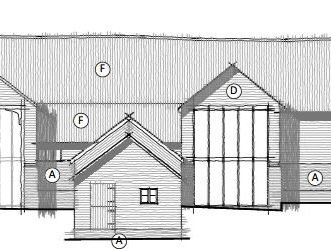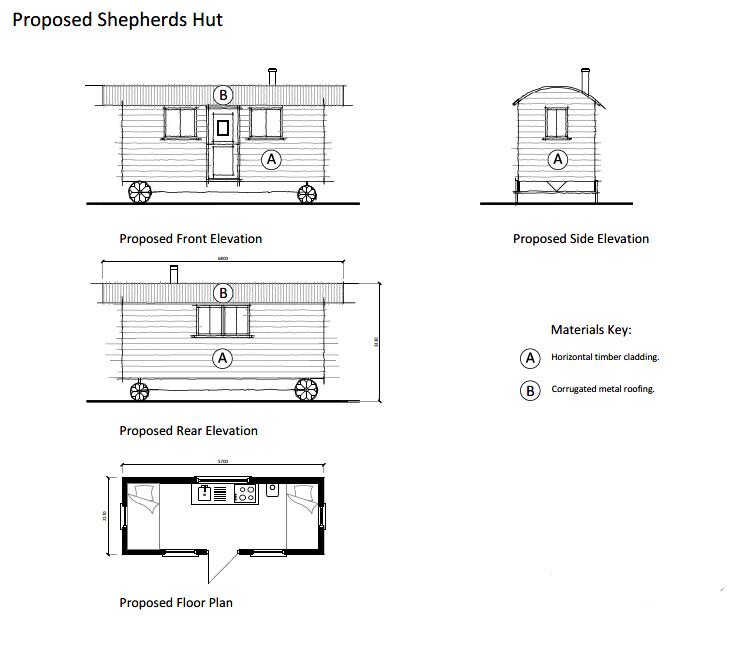Changes to Class Q of the GPDO From 21 May 2024
Permitted development rights for the conversion of buildings in 'agricultural units' into new homes
Thinking of turning that an old barn on your property into a new dwelling? Great news! New planning regulations under Class Q of the General Permitted Development 2024 aim to simplify the process of converting agricultural buildings to houses.
This article dives into the key points of the amendment, helping you understand if your project qualifies and what steps to take.
Good News for Converting Agricultural Buildings
The Class Q amendment streamlines this process for many barn conversions.
Here's what you can do under Class Q:
Convert existing agricultural buildings or former agricultural buildings into dwellings.
Make necessary modifications like installing windows, doors, utilities, or even partial demolition to make the building functional as a house.
The changes come into effect from 21 May 2024.
Important Considerations Before You Begin
While Class Q simplifies the planning process, there are limitations to keep in mind:
Land Use History: For land that is currently part of a farm:
The land must have been part of that same farm on July 24, 2023
OR if the land joined the farm after July 24, 2023, it needs to have been part of that farm for at least 10 years before you start any development
For land that used to be part of a farm but isn't anymore:
The land must have been part of a farm on July 24, 2023
AND if it stopped being part of the farm after July 24, 2023, at least 10 years must pass before you can develop it
AND since it stopped being part of the farm, you cannot have used the land for anything except farming.
Size Restrictions: The resulting dwellings cannot be bigger than 150 square meters each. There's also a cap of 10 dwellings and 1,000 square meters of total dwelling floor space allowed per agricultural unit.
Extension Limitations: Extensions are restricted to single-story additions at the back of the building, provided there is existing hardstanding, with limitations on height and distance from the existing structure. The external envelope can now also be extended to included necessary operations e.g. cladding.
Protected Areas: Conversions cannot be done on protected land or buildings (listed buildings, conservation areas, AONBs etc.).
Meeting Standards: The resulting dwellings must meet space standards and have suitable access to a public road.
Prior Approval Process: Not a Full Stop
While Class Q removes the need for full planning permission, most conversions still require prior approval from the local planning authority. This approval may involve considerations like:
Traffic impact of the new dwelling(s)
Noise levels
Contamination risks on the site
Flooding risks
Suitability of the location for a dwelling
Design and external appearance of the converted building
Provision of adequate natural light in the new home(s)
Impact of any extension on neighboring properties
Getting Started with Your Barn Conversion Project
If you're considering converting an agricultural building under Class Q, contact us at mail@adpltd.co.uk or using the form above to see how we can provide architectural and planning services to assist for barn conversion project.
The Class Q Legislation
Amendment of Class Q of Part 3
3. For Class Q (agricultural buildings to dwellinghouses) of Part 3 (changes of use) substitute—
“Class Q buildings on agricultural units and former agricultural buildings to dwellinghouses
Permitted development
Q. Development consisting of—
(a)a change of use of—
(i)a building that is part of an established agricultural unit and any land within that building’s curtilage, or
(ii)a former agricultural building that was (but is no longer) part of an established agricultural unit and any land within that building’s curtilage,
to a use falling within Class C3 (dwellinghouses) of Schedule 1 to the Use Classes Order,
(b)development referred to in sub-paragraph (a) together with the extension of the building referred to in sub-paragraph (a), or
(c)development referred to in sub-paragraph (a) together with building operations reasonably necessary to convert the building referred to in sub-paragraph (a) to a use falling within Class C3 (dwellinghouses) of that Schedule or to extend that building.
Development not permitted
Q1. Development is not permitted by Class Q if—
(a)in the case of a site that is part of an established agricultural unit, the site was not part of the established agricultural unit—
(i)on 24th July 2023, or
(ii)where the site became part of the established agricultural unit after 24th July 2023, for a period of at least 10 years before the date development under Class Q begins,
(b)in the case of a site that was (but is no longer) part of an established agricultural unit—
(i)the site was part of an established agricultural unit on 24th July 2023,
(ii)where the site ceased to be part of an established agricultural unit after 24th July 2023, the site has not been part of the established agricultural unit for a period of at least 10 years before the date development under Class Q begins, or
(iii)since ceasing to be part of an established agricultural unit, the site has been used for any non-agricultural purpose,
(c)the floor space of any dwellinghouse developed under Class Q having a use falling within Class C3 (dwellinghouses) of Schedule 1 to the Use Classes Order exceeds 150 square metres,
(d)the development under Class Q, together with any previous development under Class Q, within the original limits of an established agricultural unit (see paragraph Q.3(2) of this Part) would result in—
(i)the cumulative number of separate dwellinghouses having a use falling within Class C3 (dwellinghouses) of Schedule 1 to the Use Classes Order exceeding 10, or
(ii)the cumulative floor space of dwellinghouses having a use falling within Class C3 (dwellinghouses) of Schedule 1 to the Use Classes Order exceeding 1,000 square metres,
(e)the site is occupied under an agricultural tenancy, unless the express consent of both the landlord and the tenant has been obtained,
(f)less than 1 year before the date development begins—
(i)an agricultural tenancy over the site has been terminated, and
(ii)the termination was for the purpose of carrying out development under Class Q,
unless both the landlord and the tenant have agreed in writing that the site is no longer required for agricultural use,
(g)development under Class A(a) or Class B(a) of Part 6 of this Schedule (agricultural buildings and operations) has been carried out on the established agricultural unit during the period which is 10 years before the date development under Class Q begins,
(h)the development would result in the external dimensions of the building extending beyond the external dimensions of the existing building at any given point, other than—
(i)extension of the building allowed by paragraph Q.1(i);
(ii)protrusions of up to 0.2 metres to accommodate building operations allowed by paragraph Q.1(j)(i),
(i)the development under Class Q(b) would result in an extension that—
(i)has more than one storey,
(ii)is sited anywhere other than to the rear of the existing building,
(iii)extends beyond the rear wall of the existing building by more than 4 metres,
(iv)has eaves the height of which exceed the height of the eaves of the existing building,
(v)is higher than whichever is the lower of—
(aa)the highest part of the roof of the existing building, or
(bb)a height of 4 metres above the ground,
(vi)extends beyond a wall that forms a side or principal elevation of the existing building, or
(vii)would be sited on land that, before the development under Class Q(b), is not covered by a hard surface that was provided on the land by virtue of any development, and—
(aa)the hard surface was not provided on the land on or before 24th July 2023, or
(bb)where the hard surface was provided on the land after 24th July 2023, the hard surface has not been situated on the land for a period of at least 10 years before the date development under Class Q(b) begins,
(j)the development under Class Q(c) would consist of building operations other than—
(i)the installation or replacement of—
(aa)windows, doors, roofs, or exterior walls, or
(bb)water, drainage, electricity, gas or other services,
to the extent reasonably necessary for the building to function as a dwellinghouse, and
(ii)partial demolition to the extent reasonably necessary to carry out building operations allowed by paragraph Q.1(j)(i),
(k)the site is on article 2(3) land,
(l)the site is, or forms part of—
(i)a site of special scientific interest;
(ii)a safety hazard area;
(iii)a military explosives storage area,
(m)the site is, or contains, a scheduled monument,
(n)the building is a listed building,
(o)the existing building, excluding any proposed extension under Class Q(b) but including any proposed building operations under Class Q(c), would not be capable of complying with the nationally described space standard issued by the Department for Communities and Local Government on 27th March 2015(1) as read with the notes dated 19th May 2016 which apply to it, or
(p)the building does not have suitable existing access to a public highway.
Conditions
Q2.—(1) Where the development proposed is development under Class Q(a) together with development under Class Q(c), development is permitted subject to the condition that before beginning the development, the developer must apply to the local planning authority for a determination as to whether the prior approval of the authority will be required as to—
(a)transport and highways impacts of the development,
(b)noise impacts of the development,
(c)contamination risks on the site,
(d)flooding risks on the site,
(e)whether the location or siting of the building makes it otherwise impractical or undesirable for the building to change from agricultural use to a use falling within Class C3 (dwellinghouses) of Schedule 1 to the Use Classes Order,
(f)the design or external appearance of the building, and
(g)the provision of adequate natural light in all habitable rooms of the dwellinghouses,
and the provisions of paragraph W (prior approval) of this Part apply in relation to that application.
(2) Where the development proposed is development under Class Q(a) only, development is permitted subject to the condition that before beginning the development, the developer must apply to the local planning authority for a determination as to whether the prior approval of the authority will be required as to the items referred to in sub-paragraphs (1)(a) to (e) and (g), and the provisions of paragraph W (prior approval) of this Part apply in relation to that application.
(3) Where the development proposed includes development under Class Q(b), the developer must also apply, as part of the application under sub-paragraph (1) or (2) (as the case may be), for a determination as to whether the prior approval of the authority will be required as to the impact of the proposed extension on the amenity of any adjoining premises.
(4) Development under Class Q is permitted subject to the condition that development under Class Q(a), and under Class Q(b) or (c), if any, must be completed within a period of 3 years starting with the prior approval date.
Interpretation of Class Q
Q3.—(1) For the purposes of Class Q, “curtilage” means the lesser of—
(a)the piece of land, whether enclosed or unenclosed, immediately beside or around the building on an established agricultural unit or former agricultural building (as the case may be), closely associated with and serving the purposes of that building, and
(b)an area of land immediately beside or around the building on an established agricultural unit or former agricultural building (as the case may be) no larger than the land area occupied by that building.
(2) For the purposes of Class Q.1(d), “the original limits of an established agricultural unit” means—
(a)in the case of an established agricultural unit which ceased to exist prior to 24th July 2023, all the land which comprised the established agricultural unit at the time it came into existence;
(b)in the case of an established agricultural unit which exists on 24th July 2023, all the land which comprised the established agricultural unit at the time it came into existence;
(c)in any other case, all the land which comprises the established agricultural unit at the time it comes into existence.”.
Other Prior Approval Planning Applications
You maybe interested in some of the other key permitted development change of use allowances:
Class G – Commercial, business and service or betting office or pay day loan shop to mixed use, incorporating residential uses
Class H – Mixed use to commercial, business and service or betting office or pay day loan shop
Class L – Small HMOs to dwellinghouses and vice versa
Class M – Various uses, such as, launderette, betting office, payday loan shop, hot food takeaway to dwellings
Class MA – Class E commercial, business and service uses to dwellings
Class N – Sui Generis casino or amusement arcade to dwellings
Class R – Agricultural buildings to a flexible commercial use
Recent Change of Use Projects
Contact our planners to discuss your Class Q change of use project
If you have an agricultural building, A D P can assist you with your Class Q Prior Approval application.
Please contact us via mail@adpltd.co.uk or use the form below:
































